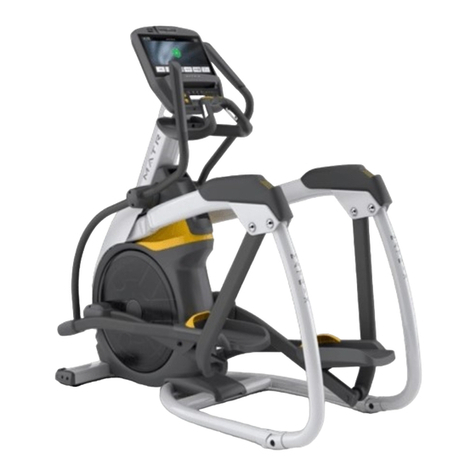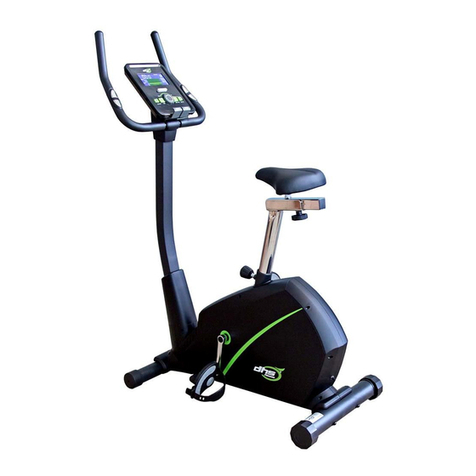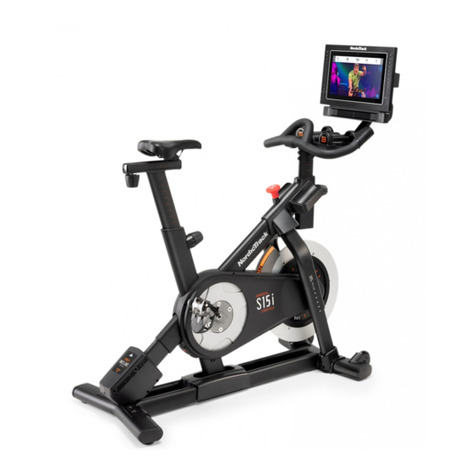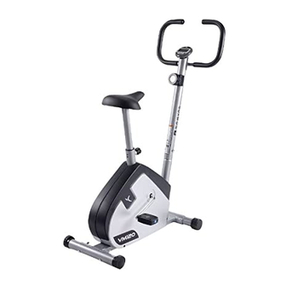BODYMAX B15 User manual

CVEB2409.CVEB2712 01.01
max. 125 kg
L 120 | W 55 | H 120
~ 60 Min.
CM
47 kg
BodyMax B15 Indoor Cycle
Assembly and Operating Instructions
SKU Code: CVEB2409 / CVEB2712

2
Indoor Cycle B15

3
Content
1 GENERAL INFORMATION 7
1.1 Technical Data 7
1.2 Personal Safety 8
1.3 Electrical Safety 9
1.4 Set-Up Place 10
2 ASSEMBLY 11
2.1 General Instructions 11
2.2 Scope of Delivery 12
2.3 Assembly 13
3 OPERATING INSTRUCTIONS 14
3.1 Heart Rate Controlled Programmes 14
4 STORAGE AND TRANSPORT 15
4.1 General Instructions 15
4.2 Transportation Wheels 15
4.3 Folding Mechanism 15
4.3.1 Folding Up the Treadmill 16
4.3.2 Unfolding the Treadmill 16
5 TROUBLESHOOTING, CARE AND MAINTENANCE 17
5.1 General Instructions 17
5.2 Faults and Fault Diagnosis 17
5.3 Error Codes and Troubleshooting 17
5.4 Care and Maintenance 18
5.4.1 Adjusting the Running Mat 18
5.4.2 Re-tensioning the Running Mat 19
5.4.3 Lubricating the Running Mat 19
5.5 Maintenance and Inspection Calendar 20
6 DISPOSAL 20
7 RECOMMENDED ACCESSORIES 21

4
Indoor Cycle B15
8 ORDERING SPARE PARTS 22
8.1 Serial Number and Model Name 22
8.2 Parts List 23
8.3 Exploded Drawing 24
9 WARRANTY 25
10 CONTACT 27

5
Dear customer,
Thank you for choosing a high-quality equipment of the brand BodyMax®. BodyMax® oers sports
and tness equipment for the sophisticated home sport and the equipment of tness studios and
business customers. With BodyMax® tness equipment, the focus is on what sport is all about:
maximum performance! Therefore, the equipment is developed in close consultation with athletes
and sports scientists. Because athletes know best what makes perfect tness equipment.
Further information can be found at www.sport-tiedje.com.
Legal Notice
Sport-Tiedje GmbH
Europe’s No. 1 for home tness
International Headquarters
Flensburger Straße 55
24837 Schleswig
Germany
Management:
Christian Grau
Sebastian Campmann
Dr. Bernhard Schenkel
No. HRB 1000 SL
Local Court Flensburg
European VAT Number: DE813211547
Disclaimer
©2016 BodyMax® is a registered brand of the company SportTiedje GmbH. All rights
reserved. Any use of this trademark without the explicit written permission of Sport-
Tiedje is prohibited.
Product and manual are subject to change. Technical data can be changed without
advance notice.
Intended Use
The equipment may only be used for its intended purpose.
The equipment is only suitable for home use. The equipment is not suitable for semi-professional
(e.g. hospitals, associations, hotels, schools, etc.) and commercial or professional use (e.g. tness
studios).

6
Indoor Cycle B15
ABOUT THIS MANUAL
Please carefully read the entire manual before installation and rst use. The manual will help you to
quickly set up the system and explains how to safely use it. Make sure that all persons exercising with
the equipment (especially children and persons with physical, sensory, mental or motor disabilities)
are informed about this manual and its contents in advance. In case of doubt, responsible persons
must supervise the use of the equipment.
This equipment has been manufactured according to the latest safety knowledge.
As far as possible, potential safety hazards which could cause injury have been
eliminated. Make sure to carefully follow the instructions and that all parts are
securely in place. If required, read through the instructions again to correct any
mistakes.
Please pay close attention to the safety and maintenance instructions given here. The contract
partner cannot be held liable for damage to health, accidents or damage to the equipment when it
is not used in accordance with these instructions.
The following safety instructions may appear in this manual:
࣑ATTENTION
This notice indicates potentially hazardous situations which, if not avoided, may result in
property damage.
⚠CAUTION
This notice indicates potentially hazardous situations which, if not avoided, may result in slight
or minor injuries!
⚠WARNING
This notice indicates potentially hazardous situations which, if not avoided, may result in death
or serious injuries!
⚠DANGER
This notice indicates potentially hazardous situations which, if not avoided, will result in death
or serious injuries!
LNOTICE
This notice indicates further useful information.
Retain these instructions in a safe place for future reference, maintenance or when ordering
replacement parts.

7
1 GENERAL INFORMATION
1.1 Technical Data
LED - Display of
+ Time in min
+ Speed in km/h
+ Distance in m
+ Calories in kcal
+ Pulse
Brake system: Magnet manual brake system
Flywheel mass: 20 kg
Weight and dimensions
Article weight (gross, including packaging): 49.5 kg
Article weight (net, without packaging): 46.5 kg
Packaging dimensions (L x W x H): approx. 107 cm x 19.5 cm x 93 cm
Set-up dimensions (L x W x H): approx. 120 cm x 55 cm x 120 cm
Maximum user weight: 125 kg

8
Indoor Cycle B15
1.2 Personal Safety
⚠DANGER
+ Before you start using the equipment, you should consult your physician that this type of
exercise is suitable for you from a health perspective. Particularly aected are persons who:
have a hereditary disposition to high blood pressure or heart disease, are over the age of 45,
smoke, have high cholesterol values, are overweight and/or have not exercised regularly in
the past year. If you are under medical treatment that aects your heart rate, medical advice
is absolutely essential.
+ Note that excessive training can seriously endanger your health. Please also note that
heart rate monitoring systems can be inaccurate. If you notice any signs of weakness,
nausea, dizziness, pain, shortness of breath, or other abnormal symptoms, stop exercising
immediately and seek advice from your doctor if necessary.
⚠WARNING
+ This equipment may not be used by children under the age of 14.
+ Children should not be allowed unsupervised access to the equipment.
+ Persons with disabilities must have a medical license and must be under strict observation
when using the equipment.
+ The equipment is strictly for use by one person at a time.
+ If your equipment provides a safety key, the clip of the safety key must be attached to your
clothing before starting your training. In the event of a fall, the EMERGENCY STOP of the
equipment can be initiated.
+ Keep your hands, feet and other body parts, hair, clothing, jewellery and other objects well
clear of moving parts.
+ During use, wear suitable sports clothing rather than loose or baggy clothing.When wearing
sports shoes, make sure they have suitable soles, preferably made of rubber or other non-
slip materials. Shoes with heels, leather soles, studs or spikes are unsuitable. Never exercise
barefoot.
⚠CAUTION
+ If your equipment needs to be connected to the power supply with a mains cable, make
sure that the cable is not a potential tripping hazard.
+ Make sure that nobody is within the range of motion of the equipment during training so as
not to endanger you or other persons.
࣑ATTENTION
+ Do not insert any objects of any kind into the openings of the device.

9
1.3 Electrical Safety
⚠DANGER
+ In order to reduce the risk of an electric shock, always unplug the equipment from the
mains socket immediately after your workout, before assembly or dismantling, and before
maintenance or cleaning. Do not pull on the cable.
⚠WARNING
+ Do not leave the equipment unattended while the mains cable is plugged into the mains
socket. During your absence, the mains cable must be removed from the mains socket to
prevent improper use by third parties or children.
+ If the mains cable or plug is damaged or defective, contact your contract partner. Until
repair, the equipment must not be used.
࣑ATTENTION
+ The equipment requires a mains connection of 220-230V with 50Hz mains voltage.
+ The equipment may only be connected directly to an earthed socket using the supplied
mains cable. Extension cables must conform to VDE guidelines. Always completely unwind
the mains cable.
+ The socket must be protected by a fuse with a minimum fuse rating of "16A, slow blow".
+ Do not make any changes to the mains cable or the mains plug.
+ Keep the mains cable away from water, heat, oil and sharp edges. Do not route the mains
cable underneath the equipment or under a carpet or rug, and do not place any objects on
top of it.

10
Indoor Cycle B15
1.4 Set-Up Place
⚠WARNING
+ Do not place the equipment in main corridors or escape routes.
⚠CAUTION
+ Choose a location in which to place the equipment such that there is enough free space/
clearance to the front, the rear and to the sides of the equipment.
+ The training room should be well ventilated during training and not be exposed to any
draughts.
+ Choose the place in which to set up the equipment such that there is enough free space/
clearance to the front, the rear and to the sides of the equipment.
+ The set-up and mounting surface of the equipment should be at, loadable and solid.
࣑ATTENTION
+ The device may only be used in one building, in suciently tempered and dry rooms
(ambient temperatures between 10°C and 35°C). The equipment should not be used
outdoors or in rooms with high humidity (over 70%) like swimming pools.
+ A oor protective mat/equipment underlay can help to protect high-quality oor coverings
(parquet, laminate, cork, carpets) from dents and sweat and can help to level out slight
unevenness.

11
2 ASSEMBLY
2.1 General Instructions
⚠DANGER
+ Do not leave any tools, packaging materials such as foils or small parts lying around,
as otherwise there is a danger of suocation for children. Keep children away from the
equipment during assembly.
⚠WARNING
+ Pay attention to the instructions attached to the equipment in order to reduce the risk of
injuries.
⚠CAUTION
+ Ensure to have sucient room for movement in each direction during assembly.
+ The assembly of the equipment must be carried out by at least two adults. If in doubt, seek
the help of a third technically skilled person.
࣑ATTENTION
+ To prevent damage to the equipment and the oor, assemble the equipment on a mat or
packaging board.
LNOTICE
+ In order to make the assembly as simple as possible, some screws and nuts to be used can
already be pre-assembled.
+ Ideally, assemble the equipment at its later set-up place.

:
:
12
Indoor Cycle B15
2.2 Assembly
Before assembly, take a close look at the individual assembly steps shown and carry out the assembly
in the order given.
LNOTICE
First loosely screw all parts together and check that they t properly. Tighten the screws using
the tool only when you are instructed to do so.
Step 1: Assembly of the Front and Rear Stabilizer
1. Mount the front stabilizer (15) to the main
frame (16) with two carriage bolts (3), two at
washers (5) and two domed nuts (6).
2. Mount the rear stabilizer (4) to the main
frame (16) with two carriage bolts (3), two at
washers (5) and two domed nuts (6).
Step 2: Assembly of the Seat Post and the Seat
1. Slide the seat post (12) into the vertical seat post
(10).
2. Align the holes at the desired position and x them
in place with an adjustment knob (7).
3. Mount the seat (13) to the seat post (12).
4. Insert the vertical seat post (10) into the main
frame (16) and line up the holes.
5. Secure the desired seat position with an
adjustment knob (7).

13
Step 3: Assembly of the Handlebar Post, the Handlebar and the Computer
1. Slide the handlebar post (17) into the handlebar post housing on the main frame (16).
2. Loosen the L shaped knob (19) and pull it back.
3. Select the desired height.
4. Release the L shaped knob (19) and retighten the knurled portion.
5. Mount the computer (78) onto the computer holder on the handlebar (18) with four bolts (72).
6. Mount the handlebar (18) onto the handlebar post (17) with an L shaped knob (77) and one at
washer (23).
7. Connect the cables A1 and A2 with one another.
8. Tighten all screw joints.
→The assembly of the equipment is now completed.

14
Indoor Cycle B15
Step 4: Assembly of the Pedals
1. Screw the right pedal (1R) clockwise onto the right
crank arm (36).
2. Screw the left pedal (1R) counter-clockwise onto the
left crank arm (33).
Step 5: Alignment of the Feet
If the oor is uneven, you can stabilize the equipment by
turning the two setting screws under the main frame.
1. Lift the equipment on the desired side and rotate the
setting screws under the main frame.
2. Rotate the screws clockwise in order to remove them
and to raise the equipment.
3. Rotate them counterclockwise in order to lower the
equipment.

15
2.2.1 Adjusting the Tension
+ To increase the resistance, turn the emergency
brake & tension control knob (30) to the right.
+ To decrease the resistance, turn the emergency
brake & tension control knob (30) to the left.
2.2.2 Using the Emergency Brake Function
⚠WARNING
Use this safety feature in any emergency
situation where you need to get o the indoor
cycle or bring the ywheel to a standstill.
Thesameknobthatallowsyoutoadjusttheresistance
of the indoor cycle also doubles as the emergency
brake.
To use the emergency brake rmly press down
on the emergency brake & tension control knob
(30).

16
Indoor Cycle B15
3 OPERATING INSTRUCTIONS
LNOTICE
Familiarise yourself with all the functions and setting options of the device before starting
training. Have the proper use of this product explained to you by a specialist.
3.1 Console Display
SCAN Display of the functions TIME - DISTANCE - CALORIES - PULSE - RPM/SPEED
in turns of 6 seconds.
RPM / SPEED Display of Rotations per Minute (RPM) and the current training speed in
turns of 6 seconds.
TIME + Display of the training time.
+ Set the target training time with the SET button (00:00 - 99:00).
DISTANCE + Display of the distance.
+ Set the target distance with the SET button (0.0 - 99.5).
CALORIES + Display of calories burned.
+ Set the target calorie value with the SET button (0 - 9990).
PULSE
+ Display of the current heart rate.
+ Set target pulse rate with the SET button.
LNOTICE
The heart rate is measured only with a chest strap.
MODE / RESET + Press this button to conrm settings.
+ Press and hold this button for 2 seconds to reset all functions.
SET
+ Press this button to set values for TIME, DISTANCE, CALORIES and
PULSE.
+ Hold this button to increase values faster.
3.2 Button Functions

17
3.3 Insertion of Battery and Switching on the Device
1. Open up the battery compartment on the back side of the console.
2. Insert one CR2032 3V battery in the battery compartment with the positive pole turning
upwards and the negative pole turning downwards.
3. Put the battery cover back on.
Once the battery is installed, the console will turn on and a beep is sounded.
4. Install the calendar settings (year, month, day and clock) and conrm each value with the MODE
button (Fig. 1).
The main menu is now displayed (Fig. 2).
3.4 Workout
To start training, start pedaling.
The values for TIME, DISTANCE and CALORIES will count upwards.
3.4.1 Target Values
1. To set target values for TIME, DISTANCE, CALORIES and PULSE, press the SET button.
The selected value is blinking.
2. To adjust the value, press the SET button.
3. To conrm the value, press the MODE button.
The training starts and the set values will count down to zero. Once you reach zero, the console will beep
for 8 seconds and the value will start counting up if you proceed to keep training.
3.4.2 Standby Mode
After four minutes of no input or training movement, the console enters the standby mode.
Press any button to re-start training. The training data are retained.
Fig. 1 Fig. 2

18
Indoor Cycle B15
4 STORAGE AND TRANSPORT
4.1 General Instructions
⚠WARNING
+ The storage location should be chosen so that improper use by third parties or children can
be prevented.
+ If your equipment does not have transportation wheels, the equipment must be
disassembled before transportation.
࣑ATTENTION
+ Make sure that the equipment is protected from moisture, dust and dirt in the selected
storage location. The storage location should be dry and well ventilated and have a constant
ambient temperature between 10°C and 35°C.
4.2 Transportation Wheels
࣑ATTENTION
If you want to transport your equipment over particularly sensitive and soft oor coverings, such
as parquet, planks or laminate, lay out the transport route with cardboard or similar to avoid
possible oor damage.
1. Stand behind the equipment and lift it until the weight is transferred to the transportation wheels.
After that, you easily can move the equipment to a new position. For long transport distances
the equipment should be disassembled and safely packed.
2. Select the new location by following the instructions in the section 1.4 of this manual.

19
5 TROUBLESHOOTING, CARE AND MAINTENANCE
5.1 General Instructions
⚠WARNING
+ Do not make any improper changes to the equipment.
⚠CAUTION
+ Damaged or worn components may aect your safety and the life of the equipment.
Therefore, immediately replace damaged or worn components. In such a case, contact the
contract partner. The equipment must not be used until it has been repaired. If necessary,
use only original spare parts.
࣑ATTENTION
+ In addition to the instructions and recommendations for maintenance and care given here,
additional service and/or repair work may be necessary; this must only be carried out by
authorised service technicians.
5.2 Faults and Fault Diagnosis
The equipment undergoes regular quality controls during production. Nevertheless, faults or
malfunctions may occur. Frequently, individual parts are responsible for these disturbances, an
exchange is usually sucient. Please refer to the following overview for the most common errors and
how to correct them. If the equipment still does not function properly, contact your contract partner.
Fault Cause Solution
Cracking in the pedal
area Pedals loose Tighten the pedals
Equipment wobbles Equipment is not level Align the feet
Handlebar/saddle
wobbles Loose screws Tighten screws rmly
Display is blank/is not
working
Batteries empty or loose
cable connection
Replace batteries or check cable
connections

20
Indoor Cycle B15
No pulse display
+ Sources of interference in
the room
+ unsuitable chest strap
+ Wrong position of chest
strap
+ Chest strap defective or
battery empty
+ Pulse display defective
+ Eliminate sources of interference (e.g.
mobile phone, WLAN, lawn mower
and vacuum cleaner robot, etc. ...)
+ Use a suitable chest strap (see
RECOMMENDED ACCESSORIES).
+ Reposition chest strap and/or
moisten electrodes
+ Changing batteries
+ Check if pulse display by hand pulse
possible
5.3 Error Codes and Troubleshooting
The electronics of the equipment continuously carries out tests. In case of deviations, an error code
appears on the display and normal operation is stopped for your safety.
Please contact Powerhouse Fitness for technical support.
This manual suits for next models
2
Table of contents
Other BODYMAX Exercise Bike manuals
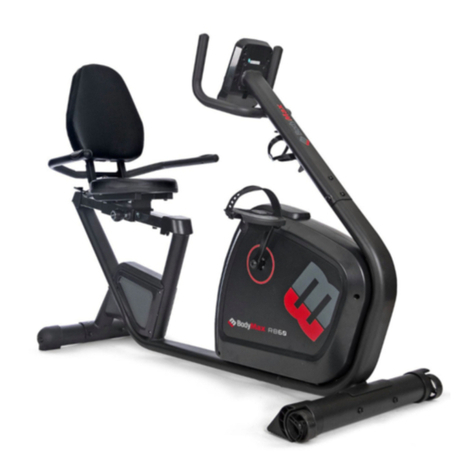
BODYMAX
BODYMAX RB60 User manual
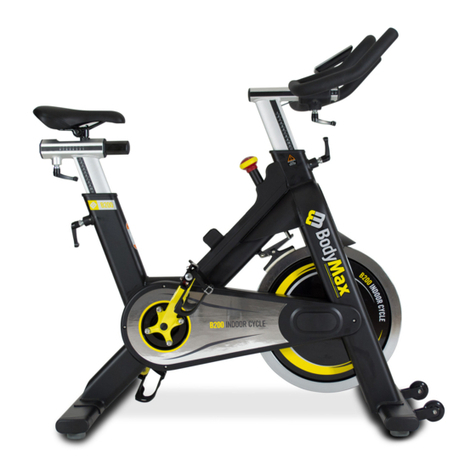
BODYMAX
BODYMAX B200 User manual

BODYMAX
BODYMAX 40 User manual
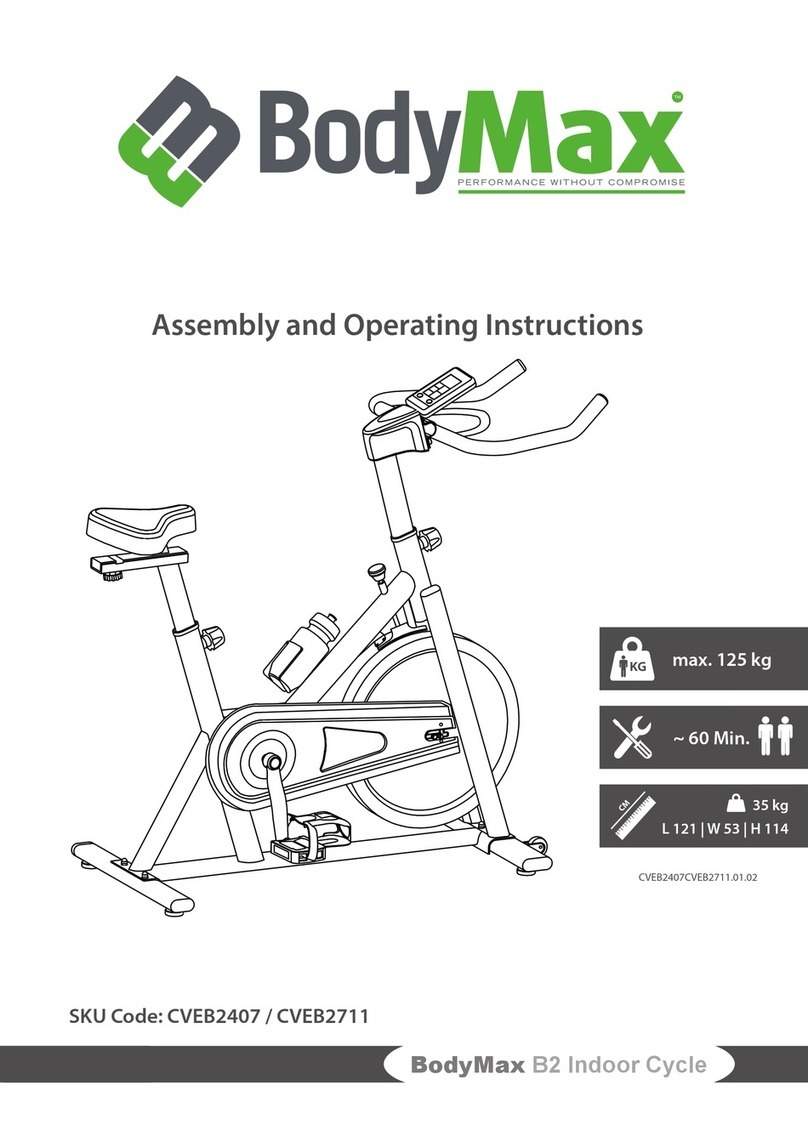
BODYMAX
BODYMAX B2 User manual

BODYMAX
BODYMAX CVEB2419 User manual

BODYMAX
BODYMAX 80 User manual
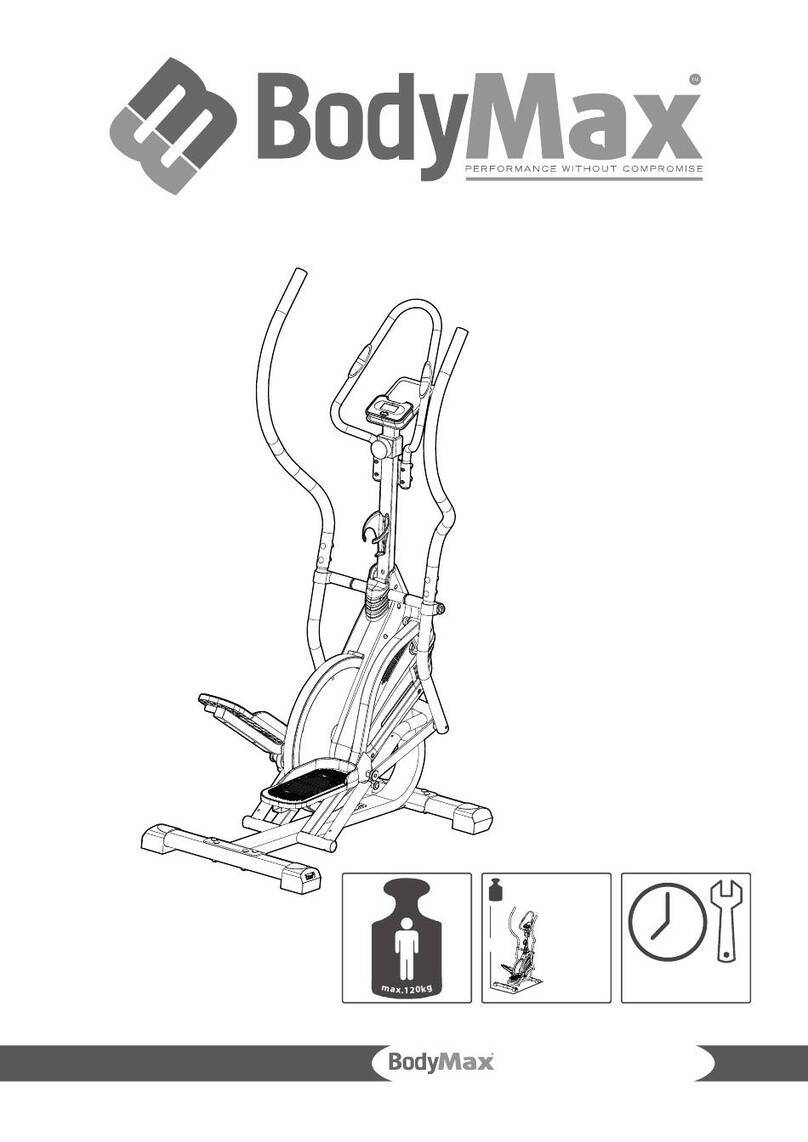
BODYMAX
BODYMAX CVET2706 User manual
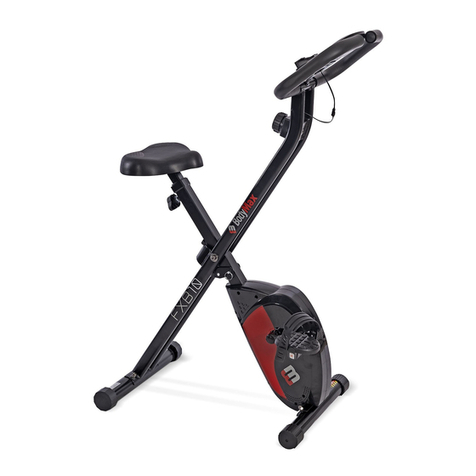
BODYMAX
BODYMAX FXB10 User manual
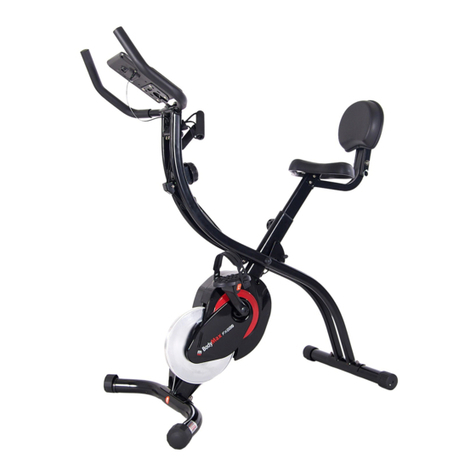
BODYMAX
BODYMAX FXB30 User manual
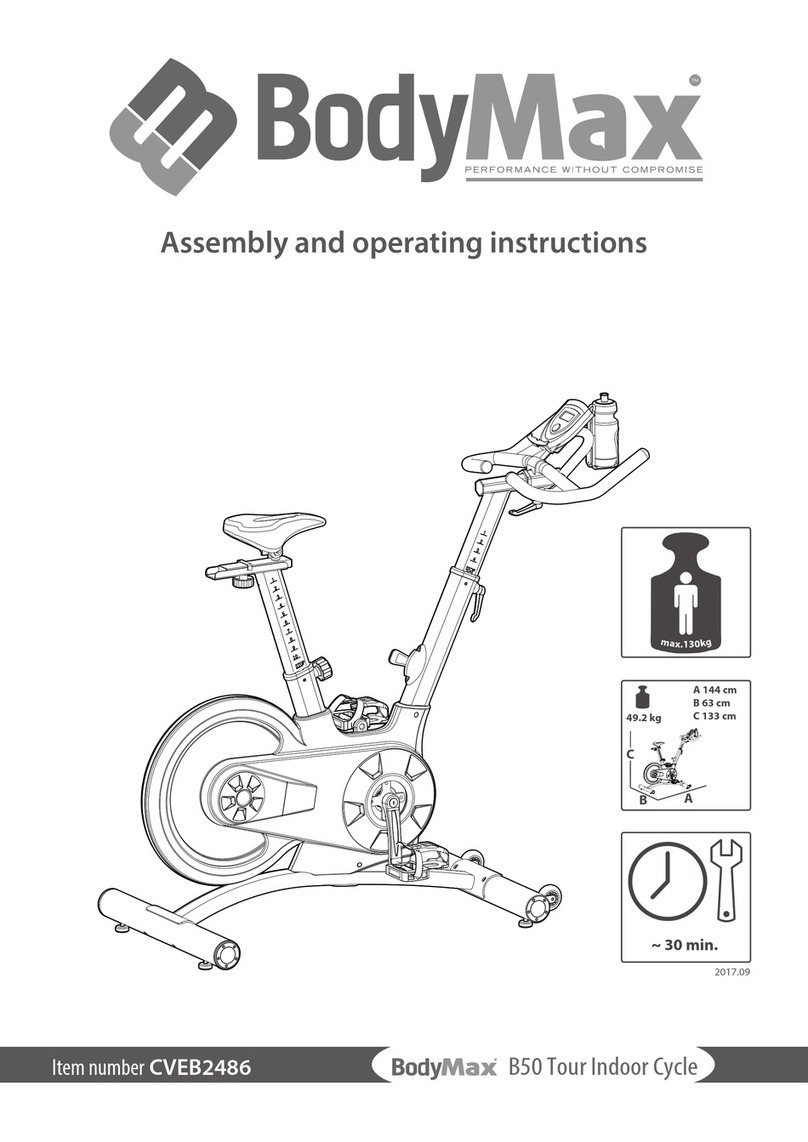
BODYMAX
BODYMAX B50 User manual
Popular Exercise Bike manuals by other brands
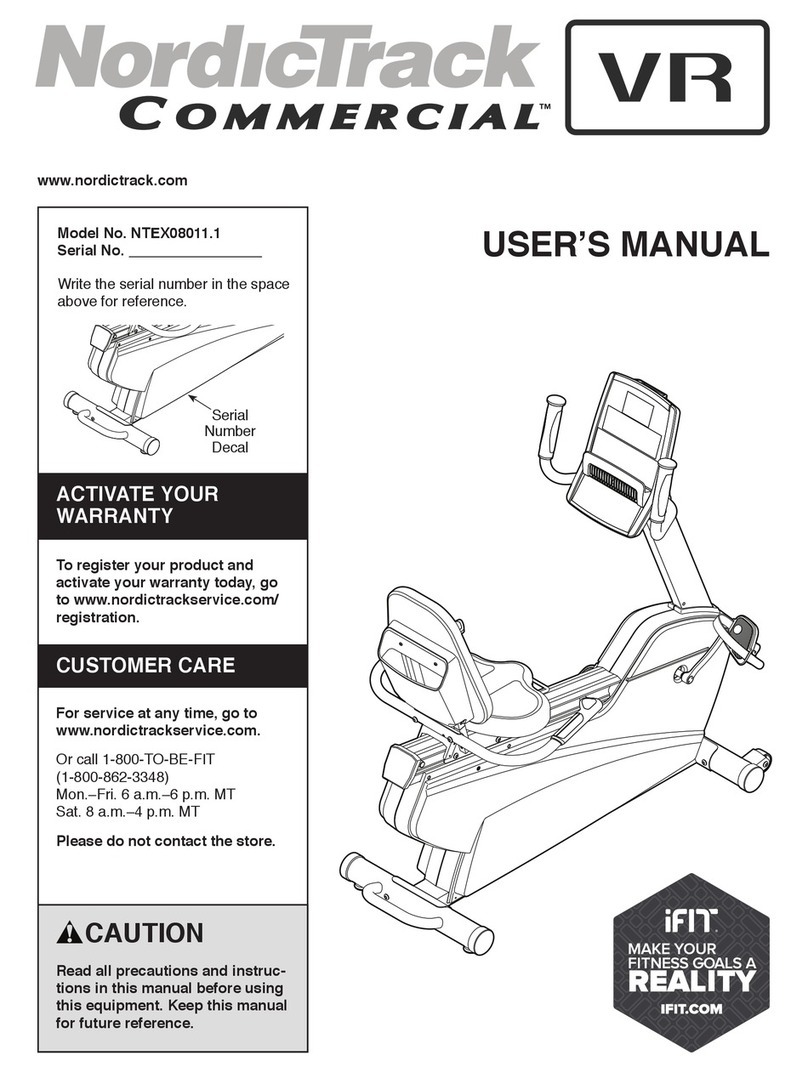
NordicTrack
NordicTrack NTEX08011.1 user manual
ICON Health & Fitness
ICON Health & Fitness PRO-FORM Le tour de france PFEX01915.1 user manual
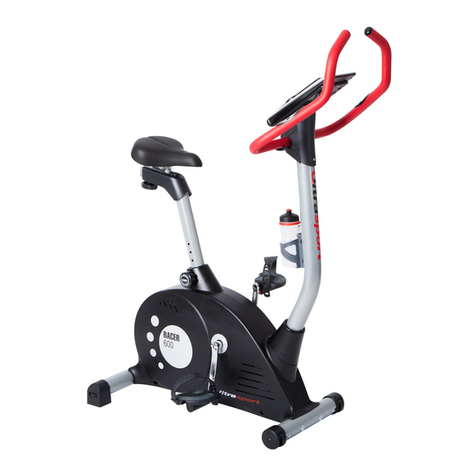
ultega
ultega ERGOMETER RACER 600 user manual

Stamina
Stamina 4600 owner's manual
ICON Health & Fitness
ICON Health & Fitness PRO-FORM Le Tour de France CSC user manual

Reebok
Reebok JET 100 SERIES Assembly guide
